Bhojpur, Madhya Pradesh
Bhojpur is a town of historical and religious importance in Raisen District of Madhya Pradesh, India.
Bhojpur
Shiv Temple | |
|---|---|
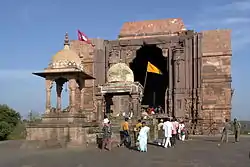 | |
 Bhojpur Location in Madhya Pradesh, India 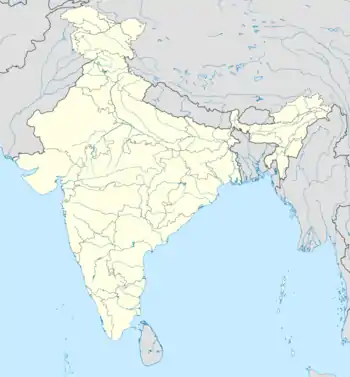 Bhojpur Bhojpur (India) | |
| Coordinates: 23°6′54″N 77°35′43″E | |
| Country | India |
| State | Madhya Pradesh |
| Languages | |
| • Official | Hindi |
| Time zone | UTC+5:30 (IST) |
| ISO 3166 code | IN-MP |
| Vehicle registration | MP |
Geography and hydrology
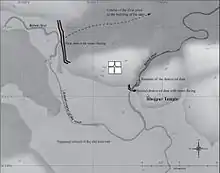
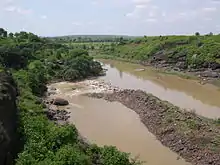
Bhojpur is situated on the Betwā River, 28 km from Bhopal, the state capital of Madhya Pradesh. The site is located on sandstone ridges typical of central India, next to a deep gorge through which the Betwā River flows. Two large dams, constructed of massive hammer-dressed stones, were built in the eleventh century to divert and block the Betwā, so creating a large lake. The approximate size of the lake is shown in the site plan given here.
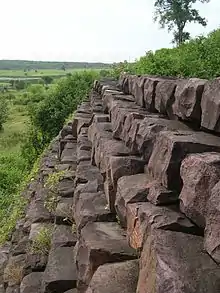
The dams were constructed of cyclopean masonry on a massive scale. The dam to the north is preserved, but the one immediately below the temple was knocked down by an exceptional surge in the Monsoon that occurred in the mid-eleventh century.[1] A myth about the Bhojpur dams has emerged thanks to the writing of William Kincaid.[2] He mis-interpreted an account in a Persian chronicle (recording that a dam was opened on the orders of Hoshang Shah of Malwa), as referring to Bhojpur, an idea elaborated by U. N. Day in 1965 and repeated subsequently in the years that followed.[3] The account, translated by U. N. Day from Persian, states that the king pulled down a dam at the request of local merchants in Bhopal and Vidisha whose caravans were being raided by bandits who would take refuge at an inaccessible spot protected by the lake. This account refers to the Bhojtal at Bhopal where even today an island in the middle of the lake can be seen. The dam at Bhopal was subsequently repaired and further raised when the Kamlapati Palace was constructed in the eighteenth century.
History
Bhojpur takes its name from king Bhoja (reg. c. 1000–1055 CE), the most celebrated ruler of the Paramāra dynasty.[4] There is no archaeological evidence from Bhojpur before the eleventh century, a fact confirmed by local legends which recount how Bhoja made a vow to build a series of dams "to arrest the streams of nine rivers and ninety-nine rivulets". A location was found in the kingdom that allowed the king to fulfil this vow and the dams were duly built at Bhojpur.[5]
Places of historical and archaeological importance
Bhojeśvar or Bhojasvāmin temple
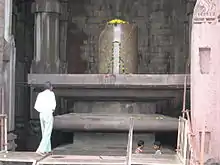
Bhojpur is famous for the incomplete Bhojeśvar temple dedicated to Shiva. The site is under the protection of the Archaeological Survey of India as a monument of national importance. The temple houses one of the largest liṅga-s in India, 5.5 m (18 ft) tall and 2.3 m (7.5 ft) in circumference. It is crafted out a single rock.[6] The liṅga was repaired by the Archaeological Survey of India who also added a roof over the top to prevent weather damage.
The attribution of the temple to Bhoja is based on the testimony of Merutuṅga, who reports in the Prabandhacintāmaṇi that Bhoja bestowed on the poet Māgha "all the merit of the new Bhojasvāmin temple that he was about to build himself", and then "set out for the country of Mālava".[7] The style of the sculpture on the building confirms an early to mid-eleventh-century date for the structure.
The building as it stands consists of the inner cella or garbhagṛha, supported by massive pillars, surmounted with an elegant corbelled dome. The outer walls and superstructure of the temple were never built, but unfinished parts lie nearby.
Quarries and rock drawings
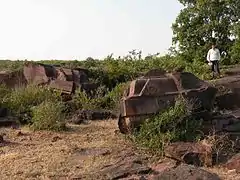
The temple at Bhojpur is unique in being left unfinished, with a series of large architectural parts still located in the quarries where the stones were cut and fashioned. In addition, there are a significant number of architectural drawings engraved on the flat surfaces of the quarry showing mouldings, pillars, and temple plans.[8] Also of note is the large earthen ramp behind the temple which shows how medieval craftsmen raised the large blocks of stone into position. The drawings and architectural parts have been subject to in-depth study and with a book on the subject published by the Indira Gandhi National Centre for the Arts.[9]
Jain temples
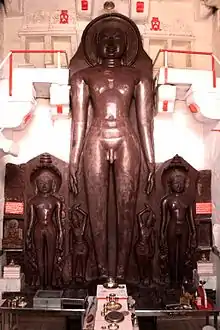
Bhojpur also has an unfinished Jain temple containing a 6-meter-tall statue of Bhagwan Shantinath and two statues of Bhagwan Parshvanath (left) and Bhagwan Suparshvanatha (right). On the base of the central images of Lord Shatinath there is an inscription mentioning king Bhoja, the only epigraphic evidence connecting Bhoja to the site.[10] The Suparshanath image on left has an inscription date samvat 1157 which mentions Naravarman, the nephew of king Bhoja, and mentions that the two smaller idols were installed by the grandson of Nemichandra of Vemaka community, who had installed the main image in the middle[11] The same temple complex hosts shrine for Ācārya Manatunga who wrote Bhaktamara Stotra.
Main Temple & Idol
This huge temple was established in year 1100 AD. The miraculous idol of principal deity Bhagwan Shantinath in standing posture (22½ feet in height) is installed in the huge sanctum of this temple. On the both sides of this idol, 2 standing beautiful idols of Bhagwan Parshvanath & Suparshvanath (7th Teerthankar) 8 feet in height each are installed. Near the feet of Bhagwan Shantinath, artistic whisk bearers are carved on both sides.
Cave of Pārvatī
Immediately opposite the temple, on the west side of the gorge facing the Betwā, is a rock-shelter or cave, now occupied by religious mendicants. Popularly known as Pārvatī's Cave, the cave contains a number of sculptures and architectural fragments dating to the eleventh century.
Remains of Bhoja's Royal Palace
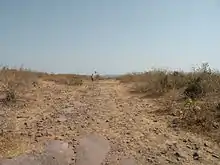
On the low plateau above the Cave of Pārvatī and opposite the Bhojpur temple are the remains of Bhoja's palace. Only the foundations survive. The complex is laid out as a grid in a square, with a courtyard in the centre (see site plan above). It is oriented on an exact north-south axis as prescribed in the Samarāṅganasūtradhāra, an architectural treatise ascribed to Bhoja.[12] Among the many features of interest are unfinished carved blocks and graffiti engraved on the rock floor. The latter includes diagrams for games and a series of names dating to the eleventh century and later. The palace is a unique survival, being the only medieval building of its kind in northern India. Its association with Bhoja and its close conformity to a text ascribed to the king mark it out as a site of national and international cultural importance. The site of the palace, like the neighbouring dams, is unprotected. The remains of the palace are being slowly destroyed as local people collect stones for modern building purposes.
Cultural activities and festivals
Every year, on the occasion of Maha Shivaratri, a big mela is organized at Bhojpur.[13]
Gallery
 Jain temple old statue
Jain temple old statue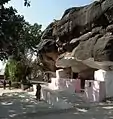 Rock shelter at Bhojpur popularly known as Pārvatī's Cave
Rock shelter at Bhojpur popularly known as Pārvatī's Cave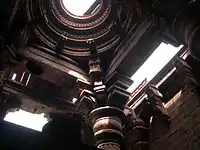 Interior of the temple dome at Bhojpur, before conservation
Interior of the temple dome at Bhojpur, before conservation Satī pillar beside the Bhojpur temple, probably 18th century.
Satī pillar beside the Bhojpur temple, probably 18th century.
References
| Wikimedia Commons has media related to Bhojpur. |
- Ashish Sinha et al, "A global context for megadroughts in monsoon Asia during the past millennium," Quaternary Science Reviews 30, no. 1–2 (January 2011): 47-62 https://doi.org/10.1016/j.quascirev.2010.10.005; B. Buckley, R. Fletcher, S. Wang, B. Zottoli and C. Pottier, “Monsoon extremes and society over the past millennium on mainland Southeast Asia,” Quaternary Science Reviews 95 (2014): 1-19.
- W. Kincaid, "Rambles among ruins in central India," The Indian Antiquary 17 (1888): 348–52.
- U. N. Day, Medieval Malwa: a Political and Cultural History, 1401–1562. (Delhi, 1965): appendix. Available for download at: Zenodo. http://doi.org/10.5281/zenodo.1063928
- Arvind K. Singh, "Interpreting the History of the Paramāras," Journal of the Royal Asiatic Society 3, 22, 1 (2012), pp. 13–28. Online version: http://journals.cambridge.org/action/displayJournal?jid=JRA
- John Malcolm, Report on the Province of Malwa, and adjoining Districts (Calcutta, 1822), p. 19.
- Bhojpur name="unfinished_dream">Unfinished dream Archived 10 February 2007 at the Wayback Machine
- Cited in M. Willis, "Dhār, Bhoja and Sarasvatī: from Indology to Political Mythology and Back," Journal of the Royal Asiatic Society 22, 1 (2012), p. 130. Online version: http://journals.cambridge.org/action/displayIssue?decade=2010&jid=JRA&seriesId=3&volumeId=22&issueId=01&iid=8509262.
- K. K. Chakravarty, Bhojpur Temple, a vision of harmony (Bhopal, 1991)
- Adam Hardy, Theory and Practice of Temple Architecture in Medieval India: Bhoja's Samarānganasūtradhara and the Bhojpur Line Drawings (New Delhi: Indira Gandhi Centre for the Arts, 2015), 307 pp. incl. many colour ills; ISBN 9789381406410
- D. C. Sircar, "Three Paramara Inscriptions", Epigraphica Indica 35 (1963–64), p. 186; H. V. Trivedi, Inscriptions of the Paramāras, 2, pp. 60–61.
- Kasturchand Jain Suman, Bharatiya Digambar Jain Abhilekh aur Tirth Parichay, Madhya-Pradesh: 13 vi shati tak, Delhi, 2001, p. 80
- Mattia Salvini, "The Samarāṅganasūtradhāra: Themes and Context for the Science of Vāstu," Journal of the Royal Asiatic Society 22, 1 (2012), pp. 35–55. Online version: http://journals.cambridge.org/action/displayJournal?jid=JRA.
- Place of Interest: Bhojpur
- Law, Bimala Churn (1926). "5. The Bhojas". Ancient Indian Tribes. Motilal Banarsidas.